Llandinam is a village situated on the A470 in Montgomeryshire, halfway between Newtown and Llanidloes and just two miles south of Caersws. The village was home to the industrialist and coal baron, Sir David Davies, who lived at Broneirion Mansion. The men of the village who fell during both World Wars are commemorated on a war memorial in the form of a Celtic Cross, which is located alongside the main road, near St. Llonio’s Church. The memorial was unveiled in 1921 with the names of the fallen carved into the stone pedestal. A bronze plaque was added after World War Two, with the names of the servicemen who fell during the latter war.
The Great War, 1914-1918
David William Bennett, Private, 290812, Royal Welsh Fusiliers. David was the son of William Bennett and Mary Bennett (nee Thomas), of Chapel House, Llandinam. He worked as a farm labourer prior to the war. David enlisted into the 3/7th Battalion, Royal Welsh Fusiliers at Newtown on 7 November 1914 and was posted to Park Hall Camp at Oswestry for training. On 31 May 1916, David embarked at Devonport aboard the HT Kalyan, and after disembarking at Alexandria, was posted to the 1/7th Battalion, Royal Welsh Fusiliers, which was attached to 158 Brigade, 53rd (Welsh) Division. The Division had been evacuated from Gallipoli in December 1915, moving to Egypt to join the EEF, and helped guard the Suez Canal before taking part in operations to drive the Turks out of the Sinai. The EEF then turned its attention onto driving the Turks out of Palestine, and on 26 March 1917 launched its first offensive against the coastal city of Gaza, which guarded the road to Jerusalem. Initial gains during the day were lost when the assaulting divisions lost touch with each other and communication broke down when a thick fog cloaked the battlefield. David was killed in action during the fighting that day. The 18-year-old is buried in Gaza War Cemetery, Israel. His father, William, died of wounds in France just weeks later.
William Bennett, Gunner, 112078, Royal Garrison Artillery. William was the son of Benjamin and Anne Bennett. He married Mary Thomas in 1899, and the couple moved to Chapel House, Llandinam. William worked as a cowman prior to the war. He enlisted into the Royal Garrison Artillery at Llandinam on 9 December 1915, and was posted to Fort Brockhurst, at Gosport, for training. William was then posted to the 259th Siege Battery, RGA, and on 11 February 1917 embarked at Southampton for France with the battery. The battery moved to the Arras sector, to support the forthcoming Arras offensive, which opened on 9 April 1917. William was badly wounded by shrapnel some days after the start of the offensive, probably when his battery was the target of counter-battery fire. He died of his wounds at the 88th Field Ambulance, Monchy-le-Preux on 18 April 1917. The 38-year-old was originally buried in Maison Rouse Cemetery, near Monchy-le-Preux, but after the war his grave was exhumed, and he was re-interred in Tilloy British Cemetery, Pas de Calais, France. His eldest son, David, had been killed in Palestine just weeks earlier.
Alfred Collins, Private, 1094, Royal Welsh Fusiliers. Alfred was born at Bridge End, Llandinam in 1892, the son of Richard and Mary Collins. His father worked as a railway labourer, and by 1911 the family had moved to Long Length, Caersws, where Alfred worked as a wheelwright. Alfred enlisted at Newtown into the 1/7th Battalion, Royal Welsh Fusiliers soon after the outbreak of war. The battalion was a Territorial unit, which mobilised for war at Newtown in August 1914, as part of North Wales Brigade, Welsh Division and moved to Conway until the end of the month, before moving to Northampton. In December the Division moved to Cambridge and then in May 1915 to Bedford, where the Division was numbered and the formation became 158 Brigade, 53rd (Welsh) Division. On 19 July 1915 the entire Division sailed from Devonport for Imbros and on 9 August 1915 landed at Suvla Bay. The infantry moved off the beaches into the bush, but due to a lack of maps and no knowledge of the terrain, many of the units became disorientated, and the situation became chaotic. Alfred was killed in action on the following day, 10 August 1915. The 23-year-old has no known grave and is commemorated on the Helles Memorial, Gallipoli. Alfred is not commemorated on the Llandinam war memorial.
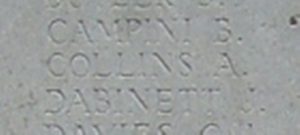
David Davies, Private, 291167, Royal Welsh Fusiliers. David was born in Llanidloes in 1890, the son of David and Anne Jane Davies. The family later resided at Waun, Llandinam. David worked as a waggoner at Llandinam prior to the war. He enlisted at Newtown into the 3/7th Battalion, Royal Welsh Fusiliers soon after the outbreak of war and was posted to Park Hall Camp, Oswestry for training. David was later posted to Egypt, joining the 1/7th Battalion, Royal Welsh Fusiliers, which was attached to 158 Brigade, 53rd (Welsh) Division. The Division had been evacuated from Gallipoli in December 1915, moving to Egypt to join the EEF, and helped guard the Suez Canal before taking part in operations to drive the Turks out of the Sinai. The EEF then turned its attention onto driving the Turks out of Palestine, and on 26 March 1917 launched its first offensive against the coastal city of Gaza, which guarded the road to Jerusalem. Initial gains during the day were lost when the assaulting divisions lost touch with each other and communication broke down when a thick fog cloaked the battlefield. A second attempt to force Gaza was launched on 17 April, which also failed, and the EEF suffered a change in leadership, with Sir Edmund Allenby assuming command, before being re-organised, and a third offensive was launched against a wider front from Beersheba to Gaza on 31 October 1917. This time the Turkish defences were breached, and the road to Jerusalem now lay open and the EEF began to advance north. On 6 November 1917, 158 Brigade launched an attack on the Khuweilfeh Heights. David was badly wounded during the attack and died of his wounds that same day. The 28-year-old is buried in Beersheba War Cemetery, Israel.
Arthur Edward Davies, Private, 54607, Royal Welsh Fusiliers. Arthur was the son of William and Alice Davies, of Penyffynon, Llydiardywain, Llanidloes. He lived and worked at Nanty Mine, Llangurig prior to the war. Arthur enlisted into the Royal Welsh Fusiliers at Welshpool, and was posted to France during the winter of 1916-17, joining the 2nd Battalion, Royal Welsh Fusiliers, which was attached to 19 Brigade, 33rd Division. The battalion had suffered heavy casualties during the Somme offensive during 1916, and Arthur probably joined the battalion after the closure of the Battle of the Somme, while it was in camp at Lesboeufs on 4 November. During the coming weeks the 2nd RWF received several drafts of reinforcements, and on 8 December the now fully rebuilt battalion moved to new positions at Suzanne, between Bapaume and Péronne. The Division remained in this sector over the coming months, before being transferred to the Arras sector, and reached Henin by 13 April, before the Division took over a section of front line facing the Hindenburg Line. The infantry battalions of the division then began the usual routines of rotating between the front-line, support and reserve trenches and the 2nd RWF took over a position known as Tunnel Trench. On 23 April the 2nd RWF took part in a costly assault on the Hindenburg Line, suffering heavy casualties. The battered battalion then moved to a rest camp at Basseux to rebuild, and by 15 May moved back into the line in the Croisilles Sector. The Division then carried out several assaults against the Hindenburg Line, but could not breach it, so on 27 May 1917 a large-scale assault was carried out again, with the 2nd RWF in the thick of the action. Arthur was killed in action during the assault that day. The 26-year-old has no known grave and is commemorated on the Arras Memorial, France.
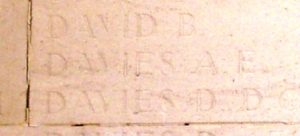
Edward Blayney Davies, Air Mechanic 1st Class, 22896, Royal Air Force. Edward was the son of Margaret Davies, of Llandinam. He was adopted as a young child by Robert Richard Pryce and Mary Anne Pryce, of Upper Ffinant, Llandinam. Edward worked as a motor mechanic prior to the war. On 8 February 1916 Edward enlisted into the Royal Flying Corps, where his skills were put to use when he re-trained as an aircraft mechanic. Edward survived the war, but became ill whilst based at Lille after the Armistice, and died of influenza there on 25 February 1919. The 28-year-old is buried in Lille Southern Cemetery, France.
Joseph Davies, Private, 29459, Royal Welsh Fusiliers. Joseph was the son of David and Jane Davies, of Waincwmyrynys, Llandinam. He worked as a farm labourer at Felindre Mill, Llanidloes prior to the war. Joseph enlisted into the 21st Battalion, Royal Welsh Fusiliers at Newtown on 22 November 1915, and was posted to Kinmel Park for training before being posted to the 19th Battalion, Royal Welsh Fusiliers. The battalion was a Bantam unit, made up of undersized men, and was attached to 119 Brigade, 40th (Bantam) Division. Joseph was just over five feet tall. On 1 June 1916 Joseph embarked for France with the battalion and the entire Division moved to the front near Loos. Late in 1916 the Division moved south to the Somme, and fought at the Battle of the Ancre, remaining in the area over the winter. In March 1917 the Germans withdrew to their shortened line, called the Hindenburg Line, and the 40th Division was one of the Divisions which followed the withdrawal. Later in the year the Division moved north to take part in the Battle of Cambrai, playing an important role in the attack on Bourlon Wood from 23-25 November. The battered Division then had a brief rest before moving to the Bullecourt sector over the winter. Joseph suffered a bullet wound to his head during a routine spell in the line on 31 January 1918, and was invalided home by 9 February. Upon his recovery, he was posted back to France on 24 May 1918, and joined the 2nd Battalion, Royal Welsh Fusiliers, which was by then on the Somme, attached to 115 Brigade, 38th (Welsh) Division. On 21 August 1918 the Division launched an offensive across the Ancre Valley, and over the coming days took Thiepval Ridge and Pozieres, before driving the Germans back across the old Somme battlefields of 1916. By 28 August the Division had reached Lesboeufs, and on 1 September 1918 launched a frontal assault on Morval and Sailly-Saillisel. Joseph was killed in action during the fighting that day. The 21-year-old is buried in Sailly-Saillisel British Cemetery, France.
James Morris Evans, Private, 49894, Royal Welsh Fusiliers. James was the son of John and Sarah Evans, of Claremont, Caersws. He worked as a joiner and builder prior to the war. James enlisted into the Royal Field Artillery at Bettisfield Park Camp on 21 November 1916, and was posted to C Battery, No 2 Reserve Brigade, RFA before being transferred to the Royal Welsh Fusiliers, and posted to the Depot at Wrexham. Whilst undergoing military training, his health broke down, and he was discharged from the army as medically unfit on 19 April 1917. James returned home, and then went to live 2, Terrace Road, Aberystwyth. He died of tuberculosis at Aberystwyth on 18 June 1918, aged 33. His remains were brought to Llandinam for burial in St. Llonio’s Churchyard. James is not commemorated on the Llandinam war memorial.
Walter Evans, Private, 1959, Montgomeryshire Yeomanry. Walter was the son of John and Ann Evans (nee Wood), of Watergate, Llanfair. He worked as a Carter at Abercastle prior to the war. Walter enlisted at Caersws into the Montgomeryshire Yeomanry soon after the outbreak of war. On 5 August 1914 the Montgomeryshire Yeomanry was mobilised at Welshpool, as part of the South Wales Mounted Brigade, before moving via Hereford to Thetford, to join the 1st Mounted Division. Walter had only been in Norfolk for a short time before he took ill, and he died at Blything Hospital, Suffolk on 29 December 1915, aged 25. He is buried in St. Edmund’s Churchyard, Southwold. His brother, George, died as a POW in 1918.
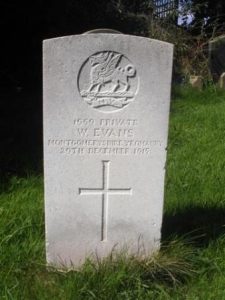
William Evans, Corporal, 290285, Royal Welsh Fusiliers. William was born in 1889 in Pencraig, Talley, Carmarthenshire, the son of James Evans. He was raised in a home before finding work at Llandinam some years before the war. William lived as a married man with Nancy Irene Gentle, and their daughter Kathleen was born at Llandinam on 24 November 1914. William enlisted into the 7th Battalion, Royal Welsh Fusiliers at Newtown on 27 August 1914. The battalion was a Territorial unit, which mobilised for war at Newtown in August 1914, as part of North Wales Brigade, Welsh Division and moved to Conway until the end of the month, before moving to Northampton. In December the Division moved to Cambridge and then in May 1915 to Bedford, where the Division was numbered and the formation became 158 Brigade, 53rd (Welsh) Division. On 19 July 1915 the entire Division sailed from Devonport for Imbros and on 9 August 1915 landed at Suvla Bay. The infantry moved off the beaches into the bush, but due to a lack of maps and no knowledge of the terrain, many of the units became disorientated, and the situation became chaotic. The Division was eventually evacuated from Gallipoli in December 1915, moving to Egypt to join the EEF, and helped guard the Suez Canal before taking part in operations to drive the Turks out of the Sinai. The EEF then turned its attention onto driving the Turks out of Palestine, and on 26 March 1917 launched its first offensive against the coastal city of Gaza, which guarded the road to Jerusalem. Initial gains during the day were lost when the assaulting divisions lost touch with each other and communication broke down when a thick fog cloaked the battlefield. William was posted as missing, believed killed in action during the fighting that day. The 27-year-old has no known grave and is commemorated on the Jerusalem Memorial, Israel. His partner Nellie, later moved to 8, Frolic Street, Newtown with their daughter Kathleen, before emigrating to Canada. She married Harold Harry, and the couple returned to Newtown, where Nellie died in 1986.
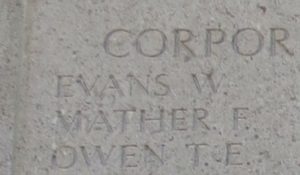
Edward Watkin Francis, Private, 37196, Royal Welsh Fusiliers. Edward was the son of Richard Francis and Eleanor Francis (nee Watkin), of Porth, Caersws. He worked on his parents’ farm prior to enlisting into the 20th Battalion, Royal Welsh Fusiliers at Newtown on 30 November 1915, and was sent to Wrexham before being posted to Kinmel Park for training. On 29 March 1916 Edward embarked for France, joining the 38th Infantry Base Depot at Étaples, before being posted to the 17th Battalion, Royal Welsh Fusiliers on 15 May. The battalion was in billets at Riez Bailleul, following a routine spell in the trenches at the Moated Grange, and was attached to 115 Brigade, 38th (Welsh) Division. The Division marched south to the Somme sector in June 1916 to take part in the assault on Mametz Wood. The first attack on the wood was launched on a two-battalion front on 7 July, but failed, and the Divisional Commander, Sir Ivor Philipps, was replaced before the Division attacked again on a two Brigade front on 10 July 1916. After two days of ferocious hand-to-hand fighting, the wood was cleared up to its northern edge, before the battered Division was relieved. It then took over a section of the front at Hébuterne before moving to the Ypres Salient, and taking over the Canal Bank sector at Boesinghe. The infantry battalions of the Division then began carrying out the normal pattern of rotation in the trenches, four days in the front, four in support and four in reserve, whilst also working on trench improvement, digging new trenches, and also carrying out regular patrols and trench raids. Edward was killed in action on 17 September 1916 whilst the 17th RWF was holding the Canal Bank sector. The 23-year-old was buried in Essex Farm Cemetery, Belgium.
Richard Benbow Griffiths, Private, 88628, The King’s (Liverpool Regiment). Richard was the son of Thomas and Margaret Griffiths of Hornby, Llandinam. He worked on his father’s farm prior to the war. Richard enlisted at Llandinam into the army, and was originally posted to the East Surrey Regiment. Upon embarking for France, he was posted to the 2nd/5th Battalion, The King’s (Liverpool Regiment), which was attached to 171st Brigade, 57th (West Lancs) Division. Richard probably joined the battalion at La Cordonnerie, among a draft of 51 men on 27 August 1917. On 20 September the battalion moved to rest billets at St. Hilaire, and remained there for almost a month, before the Division moved into the Ypres Salient, and on 26 October the 2nd/5th Liverpool’s moved into the front line at Eagle Trench, near Langemarck. Conditions on the battlefield were abysmal, as it had been raining almost since the Passchendaele offensive had been launched. To make things worse, the Germans maintained a constant rain of artillery fire onto the positions held by the battalion. Richard was wounded by shellfire at Eagle Trench, and was evacuated to the 47th Casualty Clearing Station at Dozinghem, where he died of his wounds on 29 October 1917, aged 29. He was buried in Dozinghem Military Cemetery, Belgium.
Charles Hamer, Lance Corporal, 1770, Welsh Guards. Charles was the son of David Hamer and Sarah Hamer (nee Lloyd), of Llandinam. He married Cordelia Edwards in 1911, and the couple had a son, Thomas Charles Eldon Hamer, born the following year. Charles served as a Policeman at Newtown prior to enlisting there into the 1st Battalion, Welsh Guards. He joined the battalion, which was attached to the 3rd Guards Brigade, Guards Division, in France during the summer of 1916, in time to take part in the Battle of the Somme. On the night of 8 September 1916, the Welsh Guards moved past Cuinchy through Guillemont towards the front line, in preparation to take over the line on the following morning prior to the next phase of the offensive towards Leuze Wood. The situation was confusing, and the Guardsmen struggled to get to their proper positions, encountering strong German opposition during the morning. Charles was badly wounded during heavy fighting on 10 September 1916 and died that same day. He was 32 years old and was buried on the battlefield where he fell. His grave was exhumed in 1919 and Charles was buried in Guards’ Cemetery, Lesboeufs, France. He is not commemorated on the Llandinam war memorial, but is commemorated on the new Dyfed Powys Police memorial in Carmarthen.
Daniel Jones, Sergeant, 290289, Royal Welsh Fusiliers. Daniel was the son of Edward and Martha Jones, of Hopbrook, Llandinam. He worked as a chauffeur at Bettws Hall prior to the war. Daniel had served with the Montgomeryshire Yeomanry prior to enlisting into the 7th Battalion, Royal Welsh Fusiliers at Newtown on 24 August 1914. The battalion was a Territorial unit, which mobilised for war at Newtown in August 1914, as part of North Wales Brigade, Welsh Division and moved to Conway until the end of the month, before moving to Northampton. In December the Division moved to Cambridge and then in May 1915 to Bedford, where the Division was numbered and the formation became 158 Brigade, 53rd (Welsh) Division. On 19 July 1915 the entire Division sailed from Devonport for Imbros and on 9 August 1915 landed at Suvla Bay. The infantry moved off the beaches into the bush, but due to a lack of maps and no knowledge of the terrain, many of the units became disorientated, and the situation became chaotic. The Division was eventually evacuated from Gallipoli in December 1915, moving to Egypt to join the EEF, and helped guard the Suez Canal before taking part in operations to drive the Turks out of the Sinai. The EEF then turned its attention onto driving the Turks out of Palestine, and on 26 March 1917 launched its first offensive against the coastal city of Gaza, which guarded the road to Jerusalem. Initial gains during the day were lost when the assaulting divisions lost touch with each other and communication broke down when a thick fog cloaked the battlefield. A second attempt to force Gaza was launched on 17 April, which also failed, and the EEF suffered a change in leadership, with Sir Edmund Allenby assuming command, before being re-organised, and a third offensive was launched against a wider front from Beersheba to Gaza on 31 October 1917. This time the Turkish defences were breached, and the road to Jerusalem now lay open and the EEF began to advance north. On 6 November 1917, 158 Brigade launched an attack on the Khuweilfeh Heights. Daniel was killed in action during the attack that day. The 23-year-old is buried in Beersheba War Cemetery, Israel.
George Jones, Private, 409983, Royal Air Force. George was the son of John and Mary Jane Jones, of Mount Pleasant, Llandinam. He originally enlisted into the Royal Flying Corps on 7 November 1914. George was posted to 14 Squadron, Royal Flying Corps, which was posted to the Middle East in November 1915, for Army co-operation duties during the Sinai and Palestine Campaign. The squadron was initially equipped with the B.E.2 and the D.H.1A two seat fighter, before equipping with the R.E.8 in November 1917, in time to assist the EEF’s assault on Jerusalem. The squadron remained in the Middle East following the merger of the Royal Flying Corps and the Royal Naval Air Service to form the Royal Air Force in March 1918, and carried out attacks upon the Turkish Seventh Army as it retreated following the Battle of Nablus. George almost survived the war, but died of malaria at Kantara on 31 October 1918, aged 21. He is buried in Kantara War Memorial Cemetery, Egypt.
John Jones, Sergeant, 14009, Royal Welsh Fusiliers. John was the son of John and Ellen Jones, of Pwllan Cottage, Llandinam. He worked in South Wales prior to the war, and enlisted at Pentre, Rhondda into the 11th Battalion, Royal Welsh Fusiliers. The battalion had been formed at Wrexham on 18 September 1914, before joining 67 Brigade, 22nd Division at Seaford. The Division then moved to St. Leonard’s until April 1915, when it moved to Seaford. The Division moved to Aldershot to complete its training in June 1915, before embarking for France in September 1915. The Division’s stay in France was to be very short, as within weeks it entrained for Marseilles and on 27 October 1915 began to embark for Salonika. The French and British had sent several Divisions to Salonika as a result of the Austrian and Bulgarian invasion of Serbia, which had seen the Serbian army pushed back to the Greek border. The 22nd Division took part in the Retreat from Serbia during December 1915, and took part in several battles over the coming months. John was killed in action on 15 September 1918, just days before the launching of the Second Battle of Doiran. The 29-year-old is buried in Karasouli Military Cemetery, Greece.
Richard Jones, Private, 18061, Royal Welsh Fusiliers. Richard was born at Llandinam in 1882, the son of John and Jane Jones. By 1884 the family had moved to South Wales, and later lived at 99, Tallis Street, Cwmparc, Treorchy. Richard worked as a colliery surface labourer prior to the war. He enlisted at Pentre into the Royal Welsh Fusiliers soon after the outbreak of war, and was posted to the 13th Battalion, Royal Welsh Fusiliers, which was at Llandudno attached to 128 Brigade, 43rd (Welsh) Division. The Division trained in North Wales before moving to Winchester in the summer of 1915, where the formation became renumbered 113 Brigade, 38th (Welsh) Division. The Division moved to France on 2 December 1915 and moved to the Nursery Sector near Fleurbaix for trench initiation alongside the Guards Division. The Division then held a sector of the line near Cuinchy before marching south to the Somme sector in June 1916 to take part in the assault on Mametz Wood. The first attack on the wood was launched on a two-battalion front on 7 July, but failed, and the Divisional Commander, Sir Ivor Philipps, was replaced before the Division attacked again on a two Brigade front on 10 July 1916. After two days of ferocious hand-to-hand fighting, the wood was cleared up to its northern edge, before the battered Division was relieved. It then took over a section of the front at Hébuterne before moving to the Ypres Salient, and taking over the Canal Bank sector at Boesinghe. The infantry battalions of the Division then began carrying out the normal pattern of rotation in the trenches, four days in the front, four in support and four in reserve, whilst also working on trench improvement, digging new trenches, and also carrying out regular patrols and trench raids. On 31 July 1917 the Division launched its famous assault on the Pilckem Ridge, capturing Iron Cross and reaching its objective of the Steenbeek, then played a supporting role in the Battle of Langemarck. The Division was transferred to the Sailly-sur-la-Lys sector in September, and remained in the area over the winter before being moved to positions north of Albert, at Bouzincourt Ridge, at the end of March 1918, relieving the battered 2nd and 47th Divisions. It held this sector, again carrying out minor operations and trench raids, over the coming months, before taking part in the great offensive of 21 August 1918, and began its advance towards the Hindenburg Line. Once the Hindenburg Line had been broken, the Division drove towards the Belgian frontier, and after crossing the Selle and Sambre rivers, reached the Forest of Mormal. Richard was badly wounded just days before the Armistice, and died of his wounds on 7 November 1918, aged 36. He is buried in Dourlers Communal Cemetery Extension, France. Richard is not commemorated on the Llandinam war memorial.
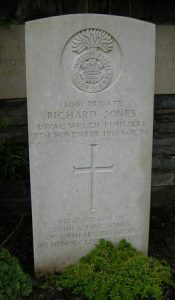
William Joseph Jones, Private, 49834, North Staffordshire Regiment. William was the son of John and Annie Jones, of Green Lane Cottage, Abermule. He lived at Carnedd, Llandinam. William had served in the army prior to the war, and as an army reservist was recalled to the colours, re-enlisting at Caersws on 11 October 1915 into the 5th Reserve Cavalry Regiment. He was then placed back onto the army reserve, and was not mobilised until 1 May 1917, when he joined the 5th Reserve Cavalry Depot at Bristol. On 3 September 1917 William was transferred to the 3rd Battalion, North Staffordshire Regiment at Wallsend, and on 17 October 1917 he embarked for France, joining the 9th Battalion, North Staffordshire Regiment, which was attached to the 37th Division, as the Divisional Pioneer battalion. William joined the battalion in the Ypres Salient, where it was based at Vierstraat, supplying working parties at Shrewsbury Forest, Fusilier Wood, Battle Wood and Hollebeke, supporting the Passchendaele offensive. On 10 January 1918 the Division moved out of the Ypres Salient, and moved to billets in various locations north-west of Aire to rest and rebuild, before moving back into the salient at the end of the month, to positions near Dickebusch, and the 9th North Staffs began work in locations at Zillebeke, the Menin Road and at Gheluvelt. The Germans launched their massive Spring offensive to the South on 21 March 1918, along the section of front line running from Croisilles to La Fère, and the Allies crumbled in the face of the onslaught. The 37th Division was rushed south, leaving the salient on 29 March, and entrained at Poperinghe for Doullens. The Division took over a section of front line between Gommecourt and Hébuterne, while the 9th North Staffs took over dugouts at Foncquevillers before beginning work consolidating the new front line. William was with a working party extending a trench line on 10 April when he was shot in the chest and was taken to the 49th Field Ambulance for treatment. He died of his wounds there on 12 April 1918, aged 25. William is buried in Doullens Communal Cemetery Extension No. 1, Somme, France. He is not commemorated on the Llandinam war memorial, but at Abermule and Llandyssil.
Edward Lewis, Private, 291026, Royal Welsh Fusiliers. Edward was the son of John and Ann Lewis, of Severn Cottage, Caersws. He worked as a railway porter prior to the war. Edward enlisted into the 2/7th Battalion, Royal Welsh Fusiliers at Newtown on 18 March 1915, and was then posted to the 1/7th Battalion, Royal Welsh Fusiliers. The battalion was a Territorial unit, which mobilised for war at Newtown in August 1914, as part of North Wales Brigade, Welsh Division and moved to Conway until the end of the month, before moving to Northampton. In December the Division moved to Cambridge and then in May 1915 to Bedford, where the Division was numbered and the formation became 158 Brigade, 53rd (Welsh) Division. On 19 July 1915 the entire Division sailed from Devonport for Imbros and on 9 August 1915 landed at Suvla Bay. The infantry moved off the beaches into the bush, but due to a lack of maps and no knowledge of the terrain, many of the units became disorientated, and the situation became chaotic. Edward survived the Gallipoli campaign, but after the battalion was evacuated, he returned to England, probably due to sickness. He served at home for the next 18 months, before embarking for France on 19 August 1917, to join the 16th Battalion, Royal Welsh Fusiliers, which was attached to 113 Brigade, 38th (Welsh) Division. Edward was wounded on 15 March 1918, and treated at the 131st Field Ambulance before being sent to the 13th General Hospital at Boulogne, and was then sent back to England again. He landed back in France on 16 September 1918, and was posted to the 14th Battalion, Royal Welsh Fusiliers, which was attached to 113 Brigade, 38th (Welsh) Division, joining the battalion a week later, at Heudecourt, where it was rebuilding following heavy losses at Gouzeaucourt. On 4 October the Division crossed the Hindenburg Line at Bony, and attacked the Beaurevoir Line at Mortho Wood on 8 October 1918, suffering heavy casualties. Edward was killed in action during the fighting that day. The 20-year-old is buried in Bois-Des-Angles British Cemetery, Crevecoeur-Sur-L’Escaut, France.
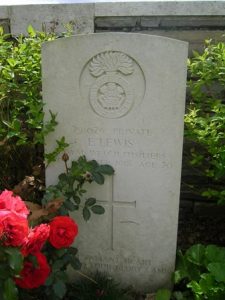
Thomas Lloyd, Private, 290817, Royal Welsh Fusiliers. Thomas was the son of Mary Lloyd, of Gronwen, Staylittle. He was raised with his uncle and aunt, David and Mary Jane Lloyd, at Bryncoch, Llandinam. Thomas enlisted into the 7th Battalion, Royal Welsh Fusiliers at Newtown on 9 November 1914. The battalion was a Territorial unit, which mobilised for war at Newtown in August 1914, as part of North Wales Brigade, Welsh Division and moved to Conway until the end of the month, before moving to Northampton. In December the Division moved to Cambridge and then in May 1915 to Bedford, where the Division was numbered and the formation became 158 Brigade, 53rd (Welsh) Division. On 19 July 1915 the entire Division sailed from Devonport for Imbros and on 9 August 1915 landed at Suvla Bay. The infantry moved off the beaches into the bush, but due to a lack of maps and no knowledge of the terrain, many of the units became disorientated, and the situation became chaotic. The Division was eventually evacuated from Gallipoli in December 1915, moving to Egypt to join the EEF, and helped guard the Suez Canal before taking part in operations to drive the Turks out of the Sinai. The EEF then turned its attention onto driving the Turks out of Palestine, and on 26 March 1917 launched its first offensive against the coastal city of Gaza, which guarded the road to Jerusalem. Initial gains during the day were lost when the assaulting divisions lost touch with each other and communication broke down when a thick fog cloaked the battlefield. A second attempt to force Gaza was launched on 17 April, which also failed, and the EEF suffered a change in leadership, with Sir Edmund Allenby assuming command, before being re-organised, and a third offensive was launched against a wider front from Beersheba to Gaza on 31 October 1917. Thomas was wounded before the launching of the battle, and died of his wounds on 28 October 1917. The 22-year-old is buried in Beersheba War Cemetery, Israel.
Edward Wynne Lloyd-Jones, MiD, Captain, Royal Welsh Fusiliers. Edward was born on 13 April 1888, the son of Reverend David Lloyd-Jones, M.A., and Annie Lloyd-Jones, of Vronhaul, Llandinam. He was a cousin to David Davies, MP. Edward was educated at Edinburgh’s Merchiston Castle School and at Emmanuel College, Cambridge, before gaining a position with Roberts & Evans, Solicitors at Aberystwyth, and was studying for his final exams to become a barrister at Aberystwyth University. Edward was commissioned into the 1st/7th Battalion, Royal Welsh Fusiliers soon after the outbreak of war. The battalion was a Territorial unit, which mobilised for war at Newtown in August 1914, as part of North Wales Brigade, Welsh Division and moved to Conway until the end of the month, before moving to Northampton. In December the Division moved to Cambridge and then in May 1915 to Bedford, where the Division was numbered and the formation became 158 Brigade, 53rd (Welsh) Division. On 19 July 1915 the entire Division sailed from Devonport for Imbros and on 9 August 1915 landed at Suvla Bay. The infantry moved off the beaches into the bush, but due to a lack of maps and no knowledge of the terrain, many of the units became disorientated, and the situation became chaotic. Edward was killed in action near Sari Bair two days later, on 10 August 1915. The 27-year-old was originally buried at Sulajik No. 2 Cemetery, Gallipoli, but after the war his grave was exhumed, and he was re-interred in Green Hill Cemetery, Gallipoli. Edward was posthumously Mentioned in Despatches. His brother Ivor served with the same battalion, and was killed in 1917.
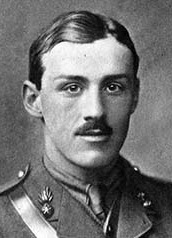
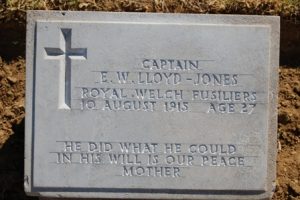
Ivor Thomas Lloyd-Jones, Captain, Royal Welsh Fusiliers. Ivor was the son of Reverend David Lloyd-Jones, M.A., and Annie Lloyd-Jones, of Vronhaul, Llandinam. He was a cousin to David Davies, MP. He was educated at Newtown County School, and at Leys School, Cambridge, and matriculated at the University of Cambridge in the summer term of 1914, and entered for Gonville and Caius College, intending to take the medical course. In October 1914 he was commissioned into the 7th Battalion, Royal Welsh Fusiliers, alongside his brother Edward. The battalion was a Territorial unit, which mobilised for war at Newtown in August 1914, as part of North Wales Brigade, Welsh Division and moved to Conway until the end of the month, before moving to Northampton. In December the Division moved to Cambridge and then in May 1915 to Bedford, where the Division was numbered and the formation became 158 Brigade, 53rd (Welsh) Division. On 19 July 1915 the entire Division sailed from Devonport for Imbros and on 9 August 1915 landed at Suvla Bay. The infantry moved off the beaches into the bush, but due to a lack of maps and no knowledge of the terrain, many of the units became disorientated, and the situation became chaotic. The Division was eventually evacuated from Gallipoli in December 1915, moving to Egypt to join the EEF, and helped guard the Suez Canal before taking part in operations to drive the Turks out of the Sinai. The EEF then turned its attention onto driving the Turks out of Palestine, and on 26 March 1917 launched its first offensive against the coastal city of Gaza, which guarded the road to Jerusalem. Initial gains during the day were lost when the assaulting divisions lost touch with each other and communication broke down when a thick fog cloaked the battlefield. Ivor was killed in action during the fighting that day. The 22-year-old is buried in Gaza War Cemetery, Israel. His brother, Edward, had been killed at Gallipoli in 1915.
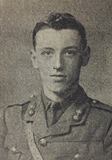
Albert Ernest Mills, Private, 55477, Royal Welsh Fusiliers. Albert was born at Thornhaugh, Northamptonshire in 1892, the son of John and Elizabeth Mills. He came to Llandinam to work as a groom prior to the war. Albert enlisted at Welshpool into the Montgomeryshire Yeomanry soon after the outbreak of war, and was posted to Park Hall Camp, Oswestry for training. Albert was then transferred to the Royal Welsh Fusiliers, and embarked for France in the winter of 1916-17, joining the 17th Battalion, Royal Welsh Fusiliers, which was attached to 115 Brigade, 38th (Welsh) Division. He joined the battalion at Ypres, where it had moved following heavy fighting at Mametz Wood in July 1916, and was holding the Canal Bank sector at Boesinghe. The infantry battalions of the Division then began carrying out the normal pattern of rotation in the trenches, four days in the front, four in support and four in reserve, whilst also working on trench improvement, digging new trenches, and also carrying out regular patrols and trench raids. On 31 July 1917 the Division launched its famous assault on the Pilckem Ridge, capturing Iron Cross and reaching its objective of the Steenbeek. Albert was killed in action during the assault that day. The 25-year-old has no known grave and is commemorated on the Ypres (Menin Gate) Memorial, Belgium. His brother Frederick Mills had been killed in France on 24 May 1915.
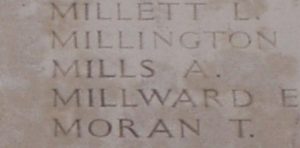
George More, Lieutenant, Welsh Regiment. George was born in Argyll, Scotland, the son of Robert and Janet Moore. By 1901 the family had moved to Tynymaen, Llandinam, where his father worked as a land steward. George married Margaret Jane Griffiths, of Ffinnant, Llandinam in 1912. George worked as Clerk to the Memorial Sanatorium at Pontywal prior to being commissioned into the 7th Battalion, Welsh Regiment (Cyclists) soon after the outbreak of war. On 6 May 1917 he embarked for France, and was posted to the 9th Battalion, Welsh Regiment, which was attached to 58 Brigade, 19th (Western) Division. George joined the 9th Welsh at Messines, where the 19th Division was preparing to take part in the forthcoming Battle of Messines Ridge. George saw his first major action when the Division attacked at Messines on 7 June, going over the top after a series of nineteen mines were blown, devastating the German defenders. The Division then enjoyed a rest before taking part in further fighting, during the Battle of the Menin Road. On the night of 19 October, the 9th Welsh moved forwards to their assembly positions, led by Major James Angel Gibbs, and on the following morning launched an assault in the direction of Hessian Wood. George was shot in the chest during the assault that morning, and was evacuated to a Casualty Clearing Station near Bailleul, where he died of his wounds on 2 October 1917. The 31-year-old is buried in Outtersteene Communal Cemetery Extension, Bailleul, France.
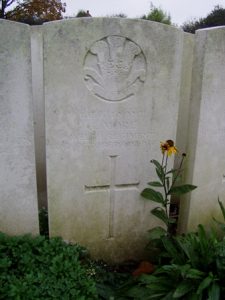
John Gurth Morgan-Owen, Second Lieutenant, South Wales Borderers. John was born at Bromsgrove in 1883, the youngest son of Timothy Morgan-Owen and Emma Morgan-Owen (nee Maddox). The family later resided at Llwynderw, Llandinam. He attended Bromsgrove School from 1898 to 1902, and played for the school rugby and cricket teams, before gaining a Scholarship from Colit House, Rhyl and went to Worcester College, Oxford. He played rugby and cricket for Oxford, and after gaining his degree in 1904 became a schoolmaster at Stonehouse, Broadstairs. Prior to the war he took up a position at St George’s College, Quibnes, Buenos Aires, but following the outbreak of war, returned to England, taking up a commission into the 4th Battalion, South Wales Borderers, alongside one of his brothers, Llewellyn Isaac Gethin Morgan-Owen. The battalion was attached to 40 Brigade, 13th (Western) Division, and had taken part in the Gallipoli campaign from 15 July 1915 until being evacuated on 8 January 1916, before moving to Egypt preparatory to being posted to Mesopotamia, embarking at Suez for Basra on 15 February 1916. John joined the battalion in Egypt, and landed at Basra with the battalion on 4 March 1916. The Division had been sent to strengthen the force being assembled for the relief of the besieged garrison at Kut al Amara. By 27 March, the Division had assembled near Sheikh Saad and came under orders of the Tigris Corps, and then took part in the attempts to relieve Kut. However, after these efforts failed and Kut fell, the British force in the theatre was built up and reorganised. John was killed in action near Sannaiyat on 9 April 1916. The 32-year-old is buried in Amara War Cemetery, Iraq. John was a brother of Welsh international footballer Lieutenant-Colonel Morgan Morgan-Owen.
David Thomas Morris, Corporal, 9259, King’s Royal Rifle Corps. David was the son of David Morris and Mary Morris (nee Orrels), of Red House, Llandinam. He enlisted into the army at Welshpool prior to the war, and was serving at Meerut, India with the 3rd Battalion, King’s Royal Rifle Corps when war broke out. On 16 October the battalion sailed from Bombay for England, before disembarking at Plymouth and entraining for Winchester, joining 80 Brigade, 27th Division. On 21 December 1914 the battalion landed at Le Havre, and the 27th Division assembled near St. Omer before taking over a section of the line running from Le Croquet to La Belle Hotesse and began digging in and extending the trenches, one of the earliest efforts which ultimately formed the line of the Western Front. Over the coming days the Division had dug a new line running southwards to the main road between Aire and Hazebrouck. By the middle of January, the Division had moved slightly north, to the Dickebusch Sector, taking over a section of line held by the French, and the infantry battalions began what would become the usual routines of trench rotation: periods of several days in the front line, followed by a period in support; and a period in reserve, all the while supplying working parties and training. The Division saw its first major fighting during the Actions of the St Eloi Craters from 27 March to 16 April 1916. On 22 April the Germans launched a massive offensive in the Ypres Salient, known as the Second Battle of Ypres, and used poison gas for the first time. Fighting raged on for weeks afterwards, with the 27th Division in the thick of the fighting. David was killed during fighting in the line between Zoave Wood and the Menin Road on 26 May 1915. The 25-year-old has no known grave and is commemorated on the Ypres (Menin Gate) Memorial, Belgium. His brother, John Edward Morris, was killed in 1918.
John Albert Morris, Private, 88646, The King’s (Liverpool Regiment). John was the son of Jane Morris (nee Turner, formerly Brown) of Oak Farm, Mochdre. He worked as a cattleman for Edward and Margaret Morris at Penthryn, Mochdre, prior to the war. John enlisted into the army at Newtown and was initially posted to the East Surrey Regiment. He was then transferred to the 2/7th Battalion, The King’s (Liverpool Regiment), which was attached to 171 Brigade, 57th (West Lancs) Division. The battalion embarked for France with the Division on 13 February 1917 and disembarked at Le Havre the following day, before moving to the Strazeele area. The Division then took over billets at Fleurbaix before moving into the front line in the Boutillerie sector, for trench initiation and training. The Division held various sectors in the area over the coming months and then in October 1917 moved north into the Ypres Salient, taking part in the Second Battle of Passchendaele. During the middle of November, the Division moved out to the Nordausques area to rest. In January 1918 the Division moved back to the Erquinghem sector and over the coming weeks again held various sectors of the front line in the area. As a result of heavy losses suffered by the Allies during the German Spring offensive, to the south, the Division left Flanders at the beginning of April and transferred to the Somme sector, near Gommecourt. From 21 August 1918 onwards, the Division took part in the great offensive, driving towards the Hindenburg Line. By 31 August John’s battalion was in position ready to assault the strongly defended village of Hendecourt and on the following day, 1 September 1918, launched its assault, capturing all of the objectives as planned. John was killed in action during the days fighting. The 22-year-old has no known grave and is commemorated on the Vis-en-Artois Memorial, France.
John Edward Morris, Second Lieutenant, Canadian Infantry. John was born on 4 July 1893, the son of David Morris and Mary Morris (nee Orrels), of Red House, Llandinam. He had emigrated to Canada prior to the war, and worked as a locomotive fireman at Moose Jaw, Saskatchewan. On 24 October 1914 John enlisted at Moose Jaw into the Canadian Expeditionary Force, stating that he had previously served for three years with the Montgomeryshire Yeomanry. John was posted to the 28th Battalion, Canadian Infantry, which embarked for Britain on 29 May 1915. It disembarked in France on 18 September 1915, as part of the 6th Infantry Brigade, 2nd Canadian Division, and took over a section of the front between Ploegsteert Wood and St. Eloi, south of Ypres. The Division saw its first major action during the Actions of the St. Eloi Craters between 27 March and 16 April 1916. John was wounded in the left arm near St. Eloi on 26 May, and was evacuated to the 2nd Canadian General Hospital. He was hospitalised for four months before being sent to the Canadian Depot at Shoreham for physical training, and did not re-join his battalion until 2 May 1917, in time to take part in the Third Battle of the Scarpe and the Battle of Hill 70, near Loos. The Canadian Corps then moved to Ypres, taking part in the Second Battle of Passchendaele from 26 October until 10 November 10, when the Corps moved south, to join the offensive at Cambrai. On 26 January 1918 John was commissioned as Second Lieutenant into the 28th Battalion. The Canadians saw heavy fighting following the German offensive of 21 March 1918, before moving to the Somme valley, and on 8 August 1918 took part in a famed assault, the Battle of Amiens, which broke the Germans. On the following day, 9 August 1918, the 6th Infantry Brigade attacked the village of Rosieres. John was the battalion scouting officer, so advanced in front of the 28th Battalion, to ascertain the general situation in front. He spotted an enemy machine-gun post, and whilst organising an attack on it, was shot through the head and instantly killed. The 25-year-old is buried in Rosieres Communal Cemetery Extension, France. His brother, David, had been killed in 1915.
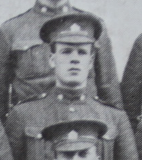
Robert Frederick Nicholas, Sapper, 275900, Royal Engineers. Robert was the son of John and Jane Elizabeth Nicholas, of New House, Caersws. He worked as a cleaner for the Cambrian Railways prior to the war and after enlisting at Newtown into the Royal Engineers, was posted to their Railway Operating Division in France. The unit had been formed in 1915 and was mainly comprised of railway employees who operated both standard and narrow-gauge railways. Robert was posted to the 34th Broad Gauge Operating Company upon his arrival in France. Robert died at one of the General Hospitals in Calais on 24 May 1918. The 24-year-old is buried in Les Baraques Military Cemetery, Sangatte, France.
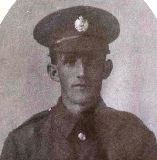
Evan Lewis Owen, Private, 291168, Royal Welsh Fusiliers. Evan was the son of Richard and Jane Owen, of Rhosfawr Farm, Oakley Park, Llanidloes. He worked as a farm labourer at Lower Gwernerin, Llandinam prior to the war. Evan enlisted into the 3/7th Battalion, Royal Welsh Fusiliers at Newtown on 26 October 1915, and was posted to Park Hall Camp, Oswestry for training. On 30 May 1916 Evan embarked for Egypt, joining the 1/7th Battalion, Royal Welsh Fusiliers, which was attached to 158 Brigade, 53rd (Welsh) Division. The Division had been evacuated from Gallipoli in December 1915, moving to Egypt to join the EEF, and helped guard the Suez Canal before taking part in operations to drive the Turks out of the Sinai. The EEF then turned its attention onto driving the Turks out of Palestine, and on 26 March 1917 launched its first offensive against the coastal city of Gaza, which guarded the road to Jerusalem. Initial gains during the day were lost when the assaulting divisions lost touch with each other and communication broke down when a thick fog cloaked the battlefield. A second attempt to force Gaza was launched on 17 April, which also failed, and the EEF suffered a change in leadership, with Sir Edmund Allenby assuming command, before being re-organised, and a third offensive was launched against a wider front from Beersheba to Gaza on 31 October 1917. This time the Turkish defences were breached, and the road to Jerusalem now lay open and the EEF began to advance north. On 6 November 1917, 158 Brigade launched an attack on the Khuweilfeh Heights. Evan was killed in action during the attack that day. The 32-year-old has no known grave and is commemorated on the Jerusalem Memorial, Israel.
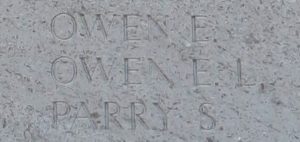
John Richards, Second Lieutenant, Royal Welsh Fusiliers. John was born in Merthyr in 1894, the son of Thomas and Ellen Richards. By 1901 the family had moved back to their native Llandinam, and lived at Caerhedyn. John worked as a domestic gardener prior to the war. He enlisted into the Grenadier Guards, with the service number 23179, and was posted to France on 27 October 1915, joining the 1st Battalion, Grenadier Guards. The battalion was attached to the Guards Division, and had seen heavy fighting during the Battle of Loos, which had been launched on 25 September 1915. John saw his first major action during the Guards Divisions fighting around the Hohenzollern Redoubt in October, following a German counter-attack. In July 1916 the Guards Division moved to the Somme, and saw heavy fighting at the Battle of Flers-Courcelette, and then afterwards at the Battle of Morval, capturing Lesboeufs Village. The Guards remained here for the winter, and in March 1917 took part in the advance caused by the German Retreat to the Hindenburg Line. On 26 June 1917 John was commissioned into the Royal Welsh Fusiliers as a Second Lieutenant, and was posted to the 16th Battalion, Royal Welsh Fusiliers, which was attached to 113 Brigade, 38th (Welsh) Division. He joined the battalion at Sailly-sur-la-Lys, near Armentieres, on 19 November 1917, where the Division had moved to rebuild following its famous assault on the Pilckem Ridge on 31 July. Over the coming weeks the infantry battalions of the Division carried out the usual routines of trench rotation, with spells in the front line, in support, and in reserve, whilst also carrying out trench raids and supplying working parties. During the evening of 15 March 1918, the 16th RWF carried out a trench raid against the German lines and entered Incandescent Trench, capturing fifteen prisoners, seizing two machine-guns, and blowing up two concrete bunkers. John was killed in action during the raid. The 23-year-old is buried in Erquinghem-Lys Churchyard Extension, France.
Frank Lewis Rowlands, Guardsman, 829, Welsh Guards. Frank was born in Llandinam in 1894, the illegitimate son of Jane Rowlands. By 1911 Frank and his mother were living at Merch House, Coldbrook Road, Cadoxton, Barry, where Jane worked as a housekeeper, and Frank worked as a printer’s assistant. Frank enlisted into the 1st Battalion, Welsh Guards at Cardiff early in 1915. The Regiment had been raised by Royal Warrant of 26 February 1915, at White City, before landing at Le Havre on 18 August 1915, becoming attached to 3rd Guards Brigade, Guards Division. The Division saw its first major action during the Battle of Loos, which began on 25 September 1915. The Welsh Guards had only been on the Western Front for little over a month, before receiving orders to attack to the south of Loos on the following day, 26 September. During the morning, the Welsh Guards marched to Vermelles with the Division, and the Division received its orders, for the 3rd Guards Brigade to assault and capture Hill 70. At zero hour on 27 September 1915, the 3rd Guards Brigade advanced, and came under murderous artillery fire, with shrapnel causing heavy casualties. Frank was killed in action at some time during the day. The 21-year-old has no known grave and is commemorated on the Loos Memorial, France. Frank is not commemorated on the Llandinam war memorial.
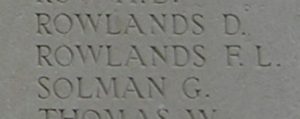
Richard Stephens, Company Sergeant Major, 290025, Royal Welsh Fusiliers. Richard was the son of Edward and Elizabeth Stephens, of Llandinam. He married Emily Evans in 1910, and the couple lived at Yew Tree Cottage, Llandinam, where Richard worked as a forester. Richard had enlisted into the 2/7th Battalion, Royal Welsh Fusiliers soon after the outbreak of war, but his health must have been too fragile for active service, as he was transferred to the 69th Company, Royal Defence Corps, with the number 46536. Richard had just survived the war, but took ill around the time of the Armistice, and died of bronchitis at Colchester General Hospital on 14 November 1918. The remains of the 30-year-old were brought home and he was buried in St Llonio’s Churchyard, Llandinam on 20 November.
Jonathan Thickens, Lance Sergeant, 290795, Royal Welsh Fusiliers. Johnathan was the son of Thomas and Miriam Thickens, of Llwynmelyn, Llandinam. He worked as a domestic gardener prior to the war. Jonathan enlisted into the 7th Battalion, Royal Welsh Fusiliers at Newtown on 2 November 1914. The battalion was a Territorial unit, which mobilised for war at Newtown in August 1914, as part of North Wales Brigade, Welsh Division and moved to Conway until the end of the month, before moving to Northampton. In December the Division moved to Cambridge and then in May 1915 to Bedford, where the Division was numbered and the formation became 158 Brigade, 53rd (Welsh) Division. On 19 July 1915 the entire Division sailed from Devonport for Imbros and on 9 August 1915 landed at Suvla Bay. The infantry moved off the beaches into the bush, but due to a lack of maps and no knowledge of the terrain, many of the units became disorientated, and the situation became chaotic. The Division was eventually evacuated from Gallipoli in December 1915, moving to Egypt to join the EEF, and helped guard the Suez Canal before taking part in operations to drive the Turks out of the Sinai. The EEF then turned its attention onto driving the Turks out of Palestine, and on 26 March 1917 launched its first offensive against the coastal city of Gaza, which guarded the road to Jerusalem. Initial gains during the day were lost when the assaulting divisions lost touch with each other and communication broke down when a thick fog cloaked the battlefield. Jonathan was killed in action during the fighting that day. The 23-year-old is buried in Gaza War Cemetery, Israel. His brother George died on 30 November 1922 after having served with the South Wales Borderers during the war.
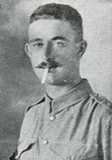
James Thomas, Sergeant, 15052, Grenadier Guards. James was the son of Evan and Hannah Thomas, of Pandy, Rhuddlan, Llanybyther. He enlisted at London into the 2nd Battalion, Grenadier Guards at some time prior to the war. At the outbreak of war, the Battalion was in Barracks at Chelsea, and on 15 August landed in France attached to 4th (Guards) Brigade, 2nd Division. The division fought at the Battle of Mons, and took part in the epic retreat from Mons to the Marne, before moving to Flanders with the BEF. The Division then saw heavy fighting at Ypres, and the Battle of Festubert the following year. In August 1915 a Guards Division was created, and the 2nd Battalion, Grenadier Guards joined 1st Guards Brigade, Guards Division, taking part in the Battle of Loos the following month. James came home on leave in October, and visited his brother David, who was living with his wife and children at Plas Dinam Cottage, Llandinam. He then visited their widowed mother, before returning to France, by which time the Guards had moved to positions near Lapugnoy. At the end of February, the Guards Division moved to the Calais area to rest and rebuild, and in the middle of March moved into the Ypres Salient, taking over the line along the Canal Bank and Potijze. At the end of July, the Division withdrew from Ypres, and began to move southwards, to the Somme sector, taking over a section of the front near Beaumont Hamel early in August. Two weeks later the Guards moved slightly south and took over positions near Bernafay Wood, where the Guards joined the great Somme offensive in earnest. On 13 September the 2nd Grenadiers moved into the Ginchy line and was ordered to make an assault to straighten the line, prior to a larger offensive two days later. James was shot in the chest during the attack, and was evacuated to hospital at Amiens, where he died of his wounds on 16 September 1916. The 26-year-old is buried in St. Pierre Cemetery, Amiens, France.
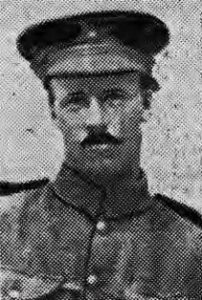
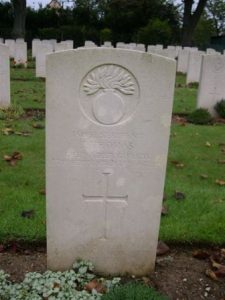
John Henry Weaver, Private, 30482, Royal Welsh Fusiliers. John was the son of John Weaver and Mary Jane Weaver (nee Wilding), of Carters Close, Llandinam. He enlisted into the Montgomeryshire Yeomanry, and after completing his training was transferred to Salonika, joining the 11th Battalion, Royal Welsh Fusiliers, which was attached to 67 Brigade, 22nd Division. The Salonika campaign had opened following the invasion of Serbia by a combined Austrian and Bulgarian offensive which had driven the Serbian army back over the Greek border in 1915. The 22nd Division took part in several major battles following its move to Salonika at the end of 1915, then on 18 September 1918 took part in the successful Battle of Doiran, which forced the Bulgarians to surrender on 30 September. John survived the campaign, but had fallen ill after contracting malaria. He eventually died of malaria at Baschurch Hospital, Shropshire on 24 November 1920. The remains of the 24-year-old were brought back to Llandinam, and he was buried in St. Llonio’s Churchyard, Llandinam on 29 November.
George Williams, Private, 291057, Royal Welsh Fusiliers. George was the son of David and Mary Ann Williams, of Llandinam. He worked as a farm labourer prior to the war. George enlisted into the 7th Battalion, Royal Welsh Fusiliers at Llanidloes on 5 April 1915. The battalion was a Territorial unit, which mobilised for war at Newtown in August 1914, as part of North Wales Brigade, Welsh Division and moved to Conway until the end of the month, before moving to Northampton. In December the Division moved to Cambridge and then in May 1915 to Bedford, where the Division was numbered and the formation became 158 Brigade, 53rd (Welsh) Division. On 19 July 1915 the entire Division sailed from Devonport for Imbros and on 9 August 1915 landed at Suvla Bay. The infantry moved off the beaches into the bush, but due to a lack of maps and no knowledge of the terrain, many of the units became disorientated, and the situation became chaotic. The Division was eventually evacuated from Gallipoli in December 1915, moving to Egypt to join the EEF, and helped guard the Suez Canal before taking part in operations to drive the Turks out of the Sinai. The EEF then turned its attention onto driving the Turks out of Palestine, and on 26 March 1917 launched its first offensive against the coastal city of Gaza, which guarded the road to Jerusalem. Initial gains during the day were lost when the assaulting divisions lost touch with each other and communication broke down when a thick fog cloaked the battlefield. George had been killed in action during the fighting that day. The 32-year-old is buried in Gaza War Cemetery.
World War Two, 1919-1945
David Davies, Major, 87746, Royal Welch Fusiliers. David was born in London on 16 January 1915, the son of Sir David Davies, MP, Baron Llandinam, and of Lady Amy Davies (nee Penman). David had been commissioned into the 7th Battalion, Royal Welch Fusiliers prior to the outbreak of war, and married Ruth Eldrydd Dugdale on 21 December 1939. The 7th RWF was attached to 158 Brigade, 53rd (Welsh) Division, and was mobilised at the outbreak of war, when the Division moved to Northern Ireland to begin garrison duties. The Division then moved to Pembroke Dock, before moving again to the south of England, where it trained in readiness for the D-Day Landings. On 24 June 1944 the 7th RWF left England for Normandy, and landed at La Riviere near Ver Sur Mer. The Division then took part in heavy fighting over the coming weeks, as part of the effort to break-out of the Normandy beach-head, seeing heavy fighting at Évrecy, before starting the epic advance through Northern France into Belgium and Holland. By now, David’s father had died, and he had become the 2nd Baron Davies of Llandinam. On 17 September 1944, David led four platoons of the 7th RWF across the Escaut Canal, north of Heide Church, and took part in an operation alongside the 5th Welch to clear Heide Wood. On 20 September the 7th RWF assisted an assault by the 4th RWF on the village of Wintelre, and heavy fighting raged in the area over the coming days. David was killed nearby on 25 September 1944. The 29-year-old was originally buried near Kerksu, but in May 1945, his grave was exhumed, and he was re-buried in Valkenswaard War Cemetery, Netherlands.
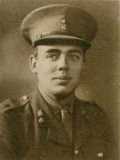
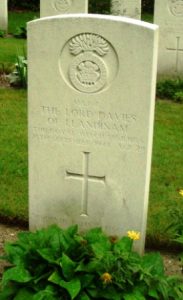
David Arthur Davies, Lance Bombardier, 1107912, Royal Artillery. David was born at Llandinam on 14 July 1912, the son of David Davies and Sarah Emily Davies (nee Humphreys). He worked as a gardener prior to the war, and had married Hannah Eluned Bound, of Llandinam, in 1938. David enlisted into the Royal Artillery, and was posted to the Far East with the 111th Anti-Tank Regiment, RA. The Regiment took part in the campaign in Burma, under arduous conditions, against a brutal enemy, during the war. David was killed in Mandalay at some time between 18-19 February 1945. The 32-year-old was originally buried in Mandalay War Cemetery, but after the war all of the war graves in the cemetery were exhumed, and moved into Taukkyan War Cemetery, Myanmar. David is not commemorated on the Llandinam war memorial.
John Gwynoro Davies, Fusilier, 14651752, Royal Welch Fusiliers. John was the son of Thomas and Annie Davies of Foel, Montgomeryshire. He enlisted into the Royal Welch Fusiliers, and was posted to the 4th Battalion, Royal Welch Fusiliers, which was attached to 158 Brigade, 53rd (Welsh) Division. The battalion was mobilised at the outbreak of war, when the Division moved to Northern Ireland to begin garrison duties. The Division then moved to Pembroke Dock, before moving again to the south of England, where it trained in readiness for the D-Day Landings. On 24 June 1944 the 7th RWF left England for Normandy, and landed at La Riviere near Ver Sur Mer. The Division then took part in heavy fighting over the coming weeks, as part of the effort to break-out of the Normandy beach-head, seeing heavy fighting at Évrecy, before starting the epic advance through Northern France into Belgium and Holland. On 15 September the Division forced the crossing of the Junction Canal North of Lommel, and continued to push westwards. John was killed near Duizel on 21 September 1944. The 22-year-old is buried in Valkenswaard War Cemetery, Netherlands.
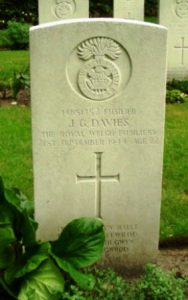
Dewi Erfyl Jones, Trooper, 7939610, Royal Armoured Corps. Dewi was born on 8 November 1907, the son of Francis Griffith Jones and Annie Elizabeth Jones, of Maesmawr, Llandinam. He worked as a bank manager at Market Drayton, Shropshire prior to the war, and married Elsie Mary Harris, of Chester, in 1941. Dewi enlisted into the 10th Royal Hussars, a former cavalry unit, which had become mechanised in 1936, and was attached to the 1st Armoured Division. The Division had fought in northern France and Belgium, returning to England without any vehicles in June 1940. After re-equipping with Crusader Tanks, in November 1941, the regiment deployed to North Africa with the 2nd Armoured Brigade, joining 7th Armoured Division. The regiment entered Benghazi on 26 December 1941, and the following month saw heavy fighting. On 28 May 1942, the regiment was attached by German dive-bombers, before taking part in a tank battle against units of the Afrika Korps. Dewi was killed during the fighting that day. The 34-year-old has no known grave and is commemorated on the Alamein Memorial, Egypt.
Arthur Norman Waldron, Fusilier, 4194294, Royal Welch Fusiliers. Arthur was born in Bromsgrove in 1916, the son of Francis Walter Waldron and Emmie Isabella Waldron (nee Horne). He married Doris Berwick, the daughter of John and Catherine Berwick, of Chirbury Road, Llandinam, in 1939. Arthur enlisted into the 7th Battalion, Royal Welch Fusiliers, which was attached to 158 Brigade, 53rd (Welsh) Division. The battalion was mobilised at the outbreak of war, when the Division moved to Northern Ireland to begin garrison duties. The Division then moved to Pembroke Dock, before moving again to the south of England, where it trained in readiness for the D-Day Landings. On 24 June 1944 the 7th RWF left England for Normandy, and landed at La Riviere near Ver Sur Mer. The Division then took part in heavy fighting over the coming weeks, as part of the effort to break-out of the Normandy beach-head, seeing heavy fighting at Évrecy, before starting the epic advance through Northern France into Belgium and Holland. On 15 September the Division forced the crossing of the Junction Canal North of Lommel, and continued to push westwards towards Elst, between Nijmegen and Arnhem, during Operation Market Garden. On 22 October the Division launched its famous assault on ‘s-Hertogenbosch, before continuing its advance to the German frontier. Between December 1944 and January 1945, the Division took part in the Battle of the Bulge, helping in the counter-attack which helped save the Americans, who were under heavy pressure, then after the German offensive was broken, took part in heavy fighting to enter the Rhineland. Arthur was killed during the fighting for the Reichswald Forest on 13 February 1945. The 29-year-old is buried in Rheinberg War Cemetery, Germany.
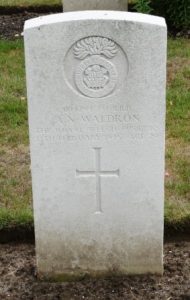
Edward Thomas Williams, Fusilier, 4189647, Royal Welch Fusiliers. Edward was the son of Evan Evans Williams and Ann Jane Williams (nee Jones), of Bwlchyllyn Isaf, Trefeglwys. He married Annie May Humphreys, of Llandinam, in 1939. Edward was a regular soldier, and was serving with the 1st Battalion, Royal Welch Fusiliers at the outbreak of war. The battalion embarked for France with the BEF, and took up positions on the River Dyle at Ottenburg, north of Wavre, where the battalion first made contact with the attacking Germans on 14 May 1940. The forward company was subjected to intense mortar fire and a series of unsuccessful attacks throughout the following day. Meanwhile the Germans had broken through near Sedan, threatening the southern flank of the BEF, and orders for the Battalion to withdraw came on the night of 15-16 May. There was no transport available initially, so the men were forced to withdraw on foot, digging in at night in case of further attacks. Trucks arrived on 18 May and took the Battalion to Tournai on the Escaut where they held the river line under heavy fire for two days. Late on 20 May, with the German forces again threatening to outflank the BEF, the 1st RWF were told to withdraw to the area north of Béthune, where they arrived on 24 May, but the shattered battalion was then ordered to advance westward to capture four bridges over the La Bassée Canal, south of Saint-Venant. The first attack was carried out on the evening of 24 May and the battalion captured Saint-Floris, but could not force their way into Saint-Venant. Fighting raged overnight and during the following days. Edward was killed in action during desperate fighting on 25 May 1940. The 31-year-old is buried in Burbure Communal Cemetery, France.
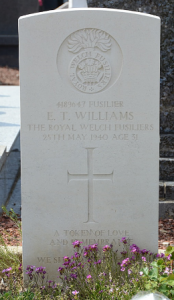
Ronald David Woosnam, Corporal, 538755, Royal Air Force. Ronald was the son of David Woosnam and Christina Lilian Woosnam (nee Coates), of The Post Office, Llandinam. He enlisted into the Royal Air Force, and was posted to North Africa with the Advanced HQ, Desert Air Force, Royal Air Force. Following the surrender of the Afrika Korps on 13 May 1943, the Allies launched an air and sea borne invasion of Sicily in July 1943, and then invaded mainland Italy. Ronald was killed in Italy on 10 April 1944. The 29-year-old was originally buried in Vasto Military Cemetery, but six weeks later, all of the graves in the cemetery were exhumed and re-buried in Sangro River War Cemetery, Italy.